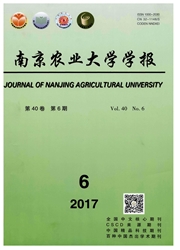

 中文摘要:
中文摘要:
[目的]本文旨在探讨凤眼莲生态修复系统中磷素的去除途径及各途径对总磷去除量的贡献率,分析凤眼莲对底泥磷释放的影响,明确系统中磷变量的去向和分配问题,为凤眼莲生态修复技术的应用提供数据支撑。[方法]在滇池气候条件下,利用漂浮植物凤眼莲,结合滇池湖水与底泥,构建凤眼莲生态修复系统,设置2种覆盖度(60%和100%),开展了为期30 d(重复3个周期)的静态模拟试验。[结果]在本试验条件下,水体总磷初始浓度较低,凤眼莲吸收作用对系统总磷去除量的贡献率最高,约占系统总磷去除量的80%左右;根系吸附对总磷去除量的贡献率较低,约为6%~8%;根系脱落物对系统总磷去除量的贡献率极低,低于2%。底泥吸附不再成为系统中的除磷途径;相反,底泥中的磷素向水体释放。凤眼莲能够有效降低水体总磷浓度,也能吸收底泥中的磷素;凤眼莲对无机磷形态中的铁/铝磷(Fe/Al-P)和有机磷(OP)的释放过程具有显著影响(P〈0.05)。种养凤眼莲降低了水体溶氧,在系统中形成厌氧条件,有利于底泥中铁/铝磷的释放。试验水体的碱性条件有利于底泥有机磷的矿化,凤眼莲的吸收作用强化了碱性条件对有机磷释放的影响。[结论]在本试验中,凤眼莲的吸收作用是该植物修复系统中的主要除磷途径,也间接促进了系统中底泥磷的释放。在野外工程实践中,凤眼莲的吸收作用对于水体磷素消减的影响主要取决于其种养面积与采收生物量。
 英文摘要:
英文摘要:
[Objectives]The purpose of the study was to discuss the phosphorus removal pathways and their contribution rates to total phosphorus removal amount in water hyacinth ecological restoration systems,to analyse the influence on phosphorus release in sediment by the macrophyte,to determine the fate of phosphorus and the balance of phosphorus total amount in the systems and to provide data to the application of water hyacinth ecological restoration technology. [Methods]A 30-days static simulation experiment with three cycles was carried out and the kinds of treatment were control,plant coverage of 60% and plant coverage of 100%,which constructed plant ecological restoration systems at Dianchi climate condition utilizing the floating plant water hyacinth with Dianchi lake water and sediment. [Results]In this experiment,under the conditions of the initial low total phosphorus( TP) concentration in water,the contribution rate( about 80%) of plant assimilation by water hyacinth to total phosphorus removal amount was highest. The contribution rate( 6%- 8%) of root adsorption to total phosphorus removal amount was low,and the contribution rate( below 2%) of root exfoliation to total phosphorus removal amount was extremely low. Sediment adsorption was no longer the phosphorus removal pathways in the plant ecological restoration systems,on the contrary,the phosphorus in sediment released to the water. Water hyacinth could effectively reduce the concentrations of total phosphorus; and could assimilate phosphorus in sediment. Water hyacinth had significant influence on the release course of Fe / Al-P forms of inorganic phosphorus and organic phosphorus( P 0. 05). Decrease of dissolved oxygen in water and formation of anaerobic conditions in systems caused by water hyacinth cultivation were beneficial to release of Fe / Al-P in sediment. Alkaline conditions in experiment water were beneficial to the mineralization of organicphosphorus in sediment,and water hyacinth assimilation reinforced the influence on the
 同期刊论文项目
同期刊论文项目
 同项目期刊论文
同项目期刊论文
 期刊信息
期刊信息
